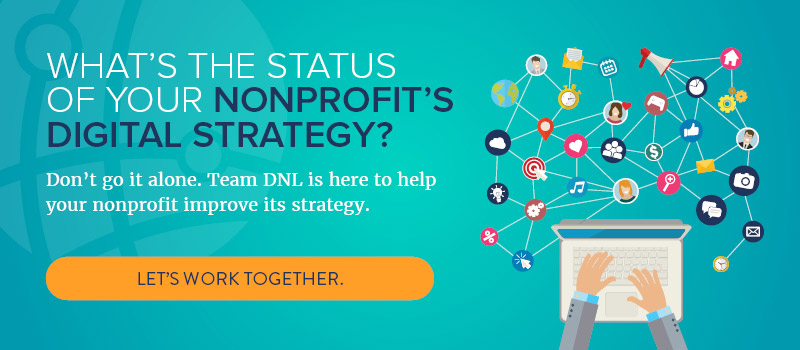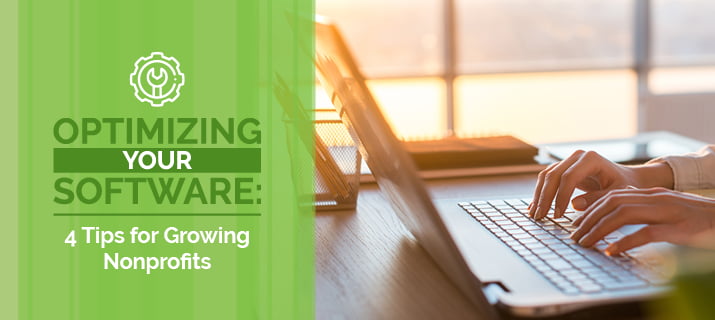Guest post blog submitted by: CharityEngine, a nonprofit technology provider.
Scaling up your nonprofit is a big step towards improved outreach and mission fulfillment. However, it can be intimidating as you assess what changes need to occur to accommodate your growth goals. Your nonprofit’s software provides valuable information about where your money is going and what your staff is doing, but don’t overlook the software itself as a potential site of change.
There is a wide range of nonprofit software on the market, and each type has its own functions and best practices. Many platforms can even scale with your organization if they have the right features.
To help your nonprofit understand and make better use of your current technology, this guide will review optimization strategies for four software solutions:
Each section of this guide will give a brief overview of the software then provide recommendations on how to adjust your nonprofit’s current usage for increased efficiency and revenue. Let’s get started.
1. CRMs
Overview
Nonprofit CRMs are optimized for managing donor data, and as your nonprofit grows, your CRM should adapt to changing needs that come with expanding fundraising and outreach efforts.
CharityEngine’s nonprofit CRM guide suggests that, with your database, you should be able to track your supporters on their journey towards donating, volunteering, and engaging in any other activities your organization offers. Your CRM should also be set up to collect information about each touch point your nonprofit has with donors, including event attendance, participation in campaigns, response to outreach messages, and giving rates.
This information allows nonprofits to create personalized experiences for donors. Scalable, robust CRMs can even be used to manage data on donors for multiple decades, allowing nonprofits to cultivate lasting relationships with major and planned donors.
Best Practices
Different CRMs come with different base features and add-ons. When purchasing a CRM, determine what features you will need as out-of-the-box tools and which can be added on using other software and integrations. For example, your nonprofit might decide that a built-in nonprofit payment processor is a must-have for security purposes, but auction management tools are optional due to hosting the event infrequently.
Complete an inventory of your current CRM’s features during your technology assessment. This should reveal any holes in your strategy that might need to be filled with a new platform. Evaluate all of your current software before investing in a new solution to ensure you are using your tools to their full potential. This will help you identify underutilized features and save resources by preventing investing in platforms with features your current tools already have.
Your CRM should also serve as your nonprofit’s hub for all donor information, meaning all information needs to flow in and out of your CRM without error. For example, if a supporter registers for an event through your signup page, the registration form should be in line with your CRM, allowing entered information to become available in your CRM.
Consider investing in an all-in-one solution or a CRM that has a wide range of native apps that can be added to your existing platform with relative ease.
2. Grant Management Software
Overview
Researching, managing, and applying for grants is a time-intensive undertaking. Growing nonprofits applying for grants should create a dedicated grant manager position who will oversee grant applications from initial outreach to check-ins with grant officers.
Effective grant management software has several key features to help your grant managers handle several essential grant management tasks. These features allow your grant manager and their team to easily pull documents for applications, track multiple grant timelines, and generate reports that meet each grantmaker’s specifications.
Best Practices
Many grant management software solutions offer multi-user access, enabling every member of your grant team to work simultaneously. However, your staff members will also need to take extra care in how they manage data to keep all documents organized.
Establish policies for how staff should interact with data to create standardized management systems moving forward. For example, create note-taking templates for your staff to use during client meetings, ensuring the information they collect will be appropriate and match the data entry forms in your CRM.
3. Matching Gift Databases
Overview
Matching gift databases analyze your donors’ information to identify further fundraising opportunities. By comparing donor information to corporate matching gift databases, matching gift software can determine if your donors are eligible for a matching gift grant and help them start their grant application.
Corporate matching gifts are additional donations made by employers when their employees give to a nonprofit. Employers have different guidelines for their matching gifts programs, such as the employee’s donation needing to meet a certain monetary threshold. Matching grant software accounts for these rules and communicates them to eligible donors to help them plan their donation accordingly.
Best Practices
Using a matching gift database is generally considered a best fundraising practice as your nonprofit can earn more from each donation. Double the Donation’s guide to matching gifts estimates that over 18 million people work for a company that offers a matching gift program. If even a fraction of those individuals donate to your nonprofit, your nonprofit can earn extra funding at no additional cost.
However, matching gift databases can only operate with your CRM if you take steps to keep your nonprofit’s data clean. Matching gift databases pull information from your CRM, which means that missing, inaccurate, or repetitive data limits their potential to find additional fundraising opportunities. Maintain good data hygiene by adding only essential information fields to donor and engagement forms to help your matching gift database generate more accurate results.
4. Event Management Software
Overview
Events drive growth and engagement by giving your supporters fun ways to get involved with your nonprofit. Both virtual and in-person events rely on having the most effective digital management tools.
Before choosing your event management software, decide what sort of event you will host. Event management software is usually designed with a specific event in mind. For example, you might decide to invest in silent auction event software, peer-to-peer event software, or virtual 5K event software.
If you’ve invested in an all-in-one CRM solution, you may already have access to the event tools you need. If your assessment funds your CRM lacks a specific event management functionality, research and consider how your desired software will integrate with your CRM and pre-existing software.
Best Practices
For high event turnout, you need friendly websites, forms, and other online tools (especially for virtual events). To make your event easy to manage for both front and back end users:
- Test all software prior to events. For videos, live-streams, and interactive media, preview how it looks on the user’s end, testing for sync delays, loading times, audio levels, and mobile support. Ensure you have a member of your technical support team available at your event if something breaks down later on.
- Remove unnecessary information fields. Keeping registration forms free of nonessential information encourages your supporters to complete their registration. Long forms can lead to page abandonment, wherein users get frustrated and leave the page before submitting their form.
- Run accessibility tests on your event webpages. Compliance with the Americans with Disabilities Act is likely a requirement for your nonprofit, and even if it’s not, you should still follow their guidelines as a courtesy to all of your supporters.
- Practice data hygiene. Ensure all of your data is accurate, up-to-date, and complete by implementing data hygiene measures. For events, this includes establishing data entry policies and structuring registration forms to guide guests towards entering useful information. For instance, you may make all fields required to ensure your capture guest emails or give multiple choice options only for how guests learned about your event as opposed to an open-ended question.
Events are an opportunity for growing nonprofits to generate more support by giving your attendees something to talk about with their friends and family. Ensure they walk away from your event remembering the event itself and not the technical difficulties they encountered trying to participate.
Nonprofit software is varied, and your organization will have many options to explore when growing your technology stack. The tips outlined in this guide should help your nonprofit assess its current practices to identify current processes that can be improved and point you towards software to invest in.
About the Author:
Philip Schmitz is the CEO and founder of cloud-services leader BIS Global, creators of the CharityEngine fundraising & communications technology platform. Founded in 1999, Phil has managed the vision and strategy for BIS’s suite of integrated business applications & hosting tools used by more than 400 businesses & non-profits.


